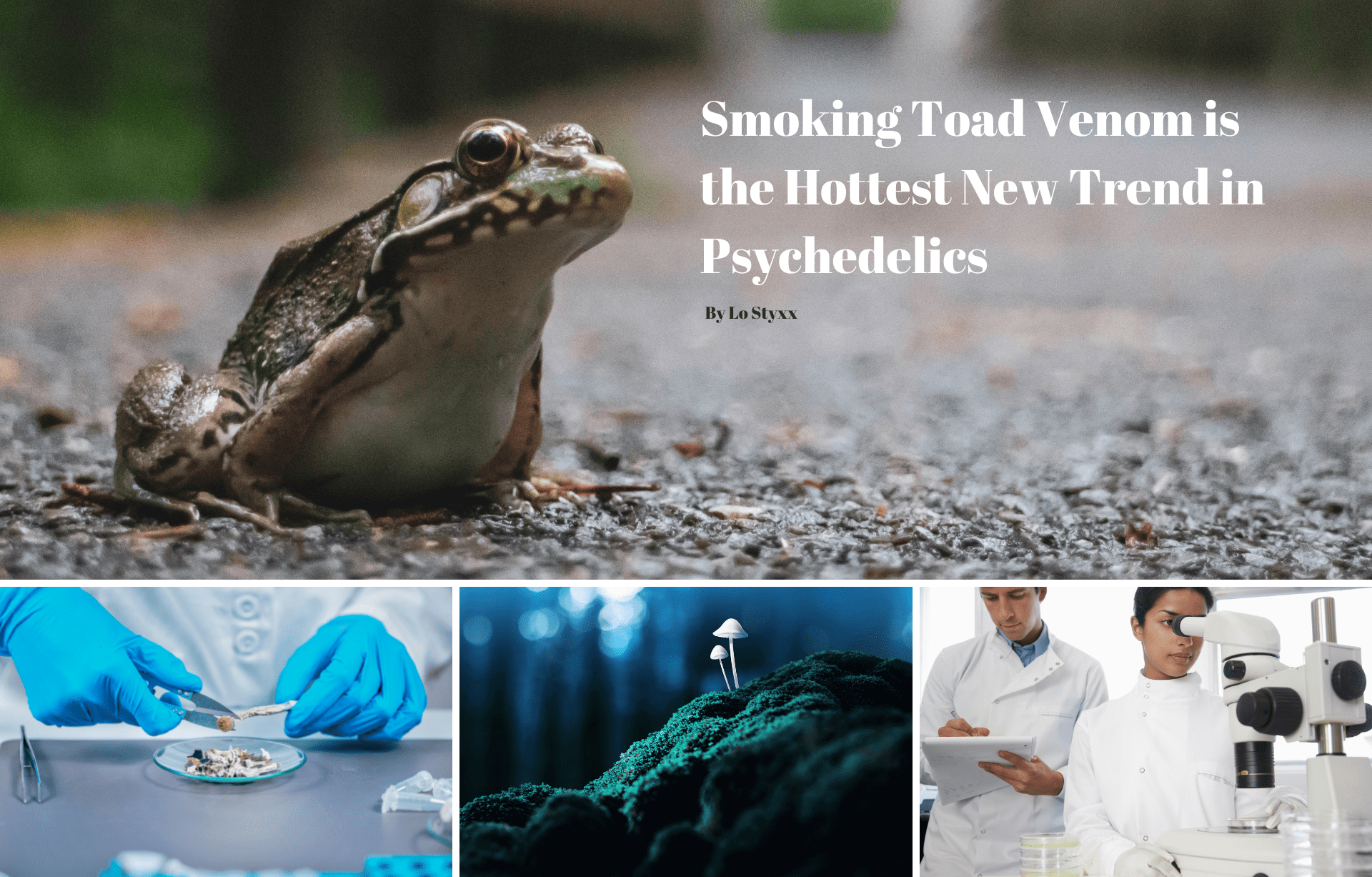
By Lo Styxx
Venom is typically considered a substance to be avoided, and toads aren’t the most appealing creatures. So, why would you ingest or smoke their venom? For the psychedelic experience, of course.
The use of toad venom as a drug is by no means new. As far back as the Middle Ages, venom from the Bufo alvarius was celebrated as a remedy for diseases. It experienced a resurgence in the counterculture of the 1960s,1 and is gaining popularity again today as such celebrities as Mike Tyson and Christina Haack have touted its life-changing properties.
The active ingredient in the venom is 5-MeO-DMT, a psychedelic chemical. While you can ingest the toad’s venom by licking its back, it’s more common to extract the venom and convert it to a powder form before smoking it. Users report that smoking the venom induces a psychedelic trip within 10-30 seconds that distorts vision and sound and can render the user physically incapacitated for about 30 minutes.
According to the Addiction Center, some users describe this trip “as a feeling of awareness, being connected to a higher power and feeling reborn.” Users often report altered mood and perception, and some even feel motivated to make major life changes due to their new outlook.2
“Many patients are not getting relief from currently approved medicines and are seeking help from nonor less regulated approaches.” “While it is unlikely that toad venom per se will be investigated for therapeutic benefit, there are several groups investigating the therapeutic benefit of 5-MeO-DMT for indications such as treatment-resistant depression and substance misuse,” says behavioral pharmacologist Joseph Araujo, chief scientific officer, and behavioral pharmacologist at Mindset Pharma, a biotechnology company dedicated to exploring and developing pharmaceutical-grade, low-cost psychedelics.
— JOSEPH ARAUJO, PHARMACOLOGIST
Araujo notes that the rise in popularity of toad venom could be the “psychedelic renaissance” we’re currently experiencing, which has bolstered the conversation around the potential utility of these substances.
“Many patients are not getting relief from currently approved medicines and are seeking help from nonor less regulated approaches,” Araujo says. “Collectively, this seems to have driven interest in several psychedelics, including 5-MeO-DMT.”
Psychedelic-Based Therapy Blends Traditional and Alternative Treatments for Depression
It’s important to note that safety data is lacking. Because 5-MeO-DMT is potent, Araujo says, there is potential for dangerous drug interactions.
“In our own studies, we have seen signs of serotonergic syndrome at high doses, which in humans can lead to fatality,” Araujo says.
Advanced addiction and substance specialist Matt Glowiak, PhD, LPC, adds that 5-MeO-DMT is classified as a schedule one narcotic in the U.S. And as with any controlled substance, there is an issue of safety concern.
At high doses, individuals may become disoriented, nauseated, and even white-out.
“At high doses, individuals may become disoriented, nauseated, and even white-out,” Glowiack says. “A hangover effect may last for several days. Further, for those with psychotic and other diagnosable mental health and addictive disorders, the experience may prove triggering—intensifying symptomology into something that exceeds one’s ability to control it. This can be scary.”
— MATT GLOWIAK, PHD, LPC
The environmental impact of milking toads for their venom is another area of concern. The Sonoran desert toad is only found in northern Mexico and the southwestern United States and is considered endangered in California and threatened in New Mexico.
Robert Anthony Villa, a researcher at the University of Arizona, has spoken publicly in the interest of protecting the species of toad, which is “susceptible to exploitation.” And the Tucson Herpetological Society launched the Sonoran Desert Toad Fund to benefit the ongoing research and conservation of the species. Some of their merchandise reads “Leave toads alone!” and “Please trip responsibly.”
One does not need to unnecessarily stress toads to obtain 5-MeO-DMT.
— JOSEPH ARAUJO, PHARMACOLOGIST
However, being responsible doesn’t necessarily mean cutting out the psychedelic experience of 5-MeODMT. It’s important for people to realize the compound can be synthesized, Araujo says.
“The effects will be the same and one does not need to unnecessarily stress toads to obtain 5-MeODMT,” he says.
Research backs this up: A 2019 study from Johns Hopkins University revealed that the synthetic version of 5-MeO-DMT can also alleviate depression.3 Another 2019 study conducted in Europe found that inhaling a single dose of 5-MeO-DMT induced feelings of greater life satisfaction while lessening feelings of anxiety, depression and PTSD.4
While more research on synthetic 5-MeO-DMT is necessary to determine its real benefit, the potential to lessen the drug’s environmental impact is incredibly valuable.